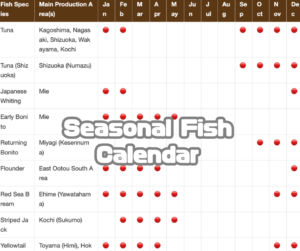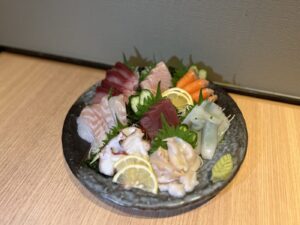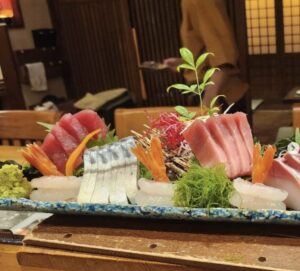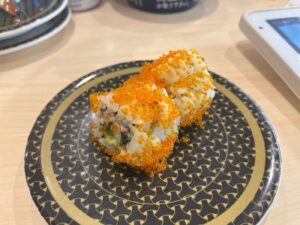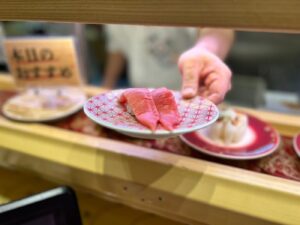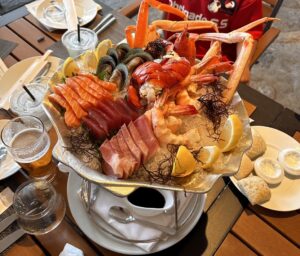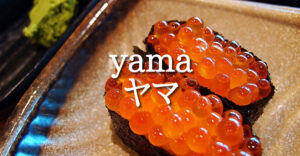Edomae sushi, a popular Japanese cuisine worldwide, is readily visible in the Japanese food section of supermarkets and restaurants in various countries, with salmon sushi taking the forefront. While it’s a highly popular sushi ingredient, especially in conveyor belt sushi restaurants in Japan, there are many aspects of salmon sushi that are not widely known. So, what exactly is salmon sushi? In this article, we will explain the delicious but somewhat complex world of salmon sushi.

The Birth and History of Salmon Sushi
How did salmon sushi come into existence and become widespread? Let’s first take a look at its origin.
What is Salmon Sushi?
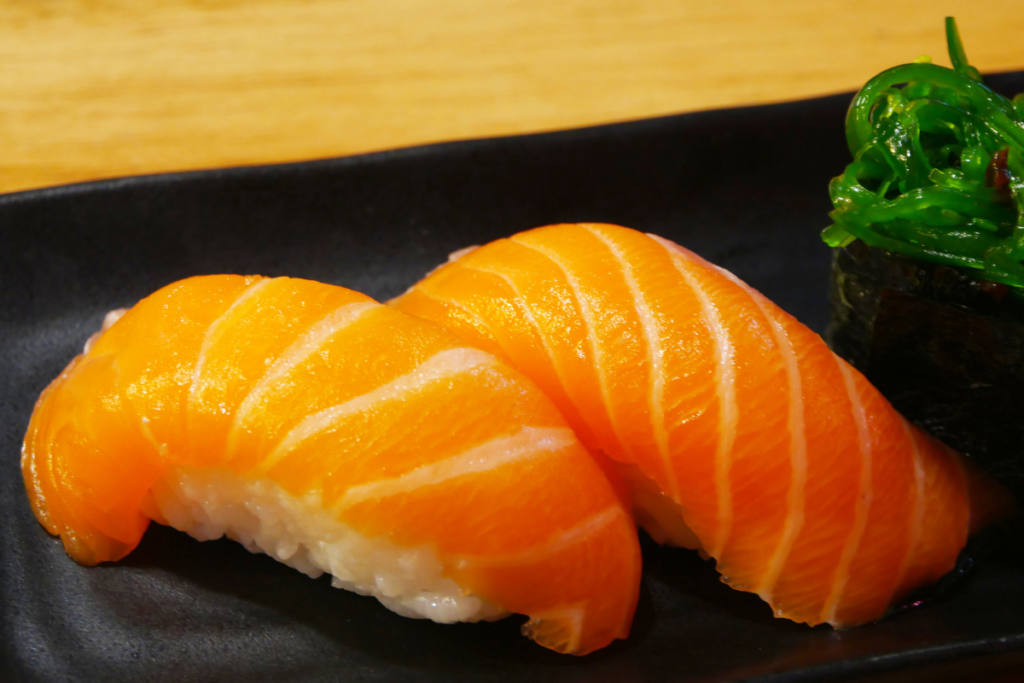
Salmon sushi is a type of sushi where salmon, rich in protein and Omega-3 fatty acids, is combined with vinegared rice. It’s known for its compatibility with other ingredients, and variations include combinations with onions and mayonnaise, among others. In conveyor belt sushi restaurants, you can find a wide range of salmon sushi options beyond the simple version, such as onion salmon sushi and salmon mayo sushi.
The Origin of Salmon Sushi

Interestingly, during the early days of Edomae sushi, salmon was not considered a sushi ingredient. In fact, what is commonly known as salmon sushi today did not originate in Japan. Until the late 1980s, salmon was not associated with sushi in Japan because it was believed that salmon, known as “sake” in Japanese, was prone to parasites like Anisakis, making it unsuitable for raw consumption. However, Norway, which had successfully developed salmon without parasites, initiated “Project Japan” in 1986 as part of its strategy to promote Norwegian salmon in the international market. This project aimed to introduce salmon as a sushi ingredient in Japan, and it marked the beginning of the history of salmon sushi as a sushi topping. Delicious salmon sushi quickly spread not only throughout Japan but also worldwide, becoming one of the most popular sushi toppings.
Why is Salmon Sushi Popular in Conveyor Belt Sushi?
While salmon sushi is a staple in conveyor belt sushi restaurants, you won’t find it as commonly in high-end sushi counters. This is primarily due to the historical background of salmon’s introduction to sushi in Japan. Edomae sushi, as the name suggests, originated in Tokyo, specifically in the Edo Bay area. However, Edo Bay was not known for salmon fishing, and transporting salmon from regions where it was available posed a high risk due to the presence of parasites. As a result, the tradition of consuming raw Japanese salmon in Edomae sushi did not develop. Nevertheless, some sushi artisans who value tradition may still avoid using salmon as a sushi topping in high-end establishments. In contrast, conveyor belt sushi, with its shorter history, does not have these constraints, making salmon an ideal sushi ingredient.
Differences Between Salmon, Trout, and Masu (Trout)
Salmon, trout, and masu (trout) can be confusing because they often look and taste similar. While there is no biological distinction between salmon and trout, we will explain how they are generally distinguished in this article.
Salmon

In Japan, “salmon” in the strict sense refers to the salted salmon known as “shiozake,” which belongs to the Salmonidae family, Salmoninae subfamily, Salmo genus. However, the names “ginmasu” and “benimasu,” which were once used to refer to chum salmon and coho salmon, have also become less common, and they are now often simply called “salmon.”
Salmon

The English name for salmon is “salmon,” which can be confusing. Generally, when people say “salmon,” they are referring to Atlantic salmon and trout salmon. Atlantic salmon, as mentioned earlier, is primarily exported by Norway to various countries and has become synonymous with the brand “Norwegian Salmon.” Trout salmon, on the other hand, is commonly available in Japan and is mainly produced in South American countries like Chile and Norway. The term “trout” in trout salmon refers to the rainbow trout, a freshwater fish that is raised in the sea, resulting in larger individuals than traditional rainbow trout.
Masu (Trout)

Within the Salmonidae family, which includes salmon and trout, the term “masu” or names containing “masu” refer to various fish species. In the market, the North Pacific salmon known as “karafuto masu” is called “masu,” distinguishing it from “sakuramasu,” which is a term used for Japanese-produced salmon. While dictionaries often refer to “masu” primarily as “karafuto masu” and “sakuramasu,” in practice, the distinction can be challenging. For example, the scientific name “Oncorhynchus masou” is associated with trout salmon, but it may appear as “masunosuke” in Japanese, adding to the complexity.
Summary of Differences Between Salmon, Trout, and Masu
In summary, the differences between salmon, trout, and masu are influenced by language, history, and common usage. Biologically, these distinctions are not always clear-cut. From a general perspective:
- Salmon refers to various species within the Salmonidae family, including ginmasu, benimasu, and benizake, all of which belong to the Salmo genus.
- Salmon, in the sense of sushi and cuisine, encompasses a broader range of species within the Salmonidae family, including rainbow trout (trout salmon) and king salmon (chinook salmon), as well as Atlantic salmon from the Salmo genus.
- Masu typically refers to the North Pacific salmon, karafuto masu, and may also include sakuramasu, which is a term used for Japanese-produced salmon.
Various Types of Salmon Sushi
Salmon sushi is incredibly popular both domestically and internationally, and one of the reasons for its popularity is its rich variety. What are the different types of salmon sushi? Let’s explore the types of salmon and sushi menu items associated with them.
Types of Fish Used in Salmon Sushi
In conveyor belt sushi restaurants, farmed Atlantic salmon and trout salmon are the primary choices for salmon sushi. Additionally, sakuramasu (cherry salmon) is used in regional dishes such as “masuzushi” in Toyama Prefecture.
Varieties of Salmon Sushi
Various types of salmon sushi can be found in conveyor belt sushi restaurants, each offering unique flavors that delight the palate. Some well-known types of salmon sushi include:
Toro Salmon
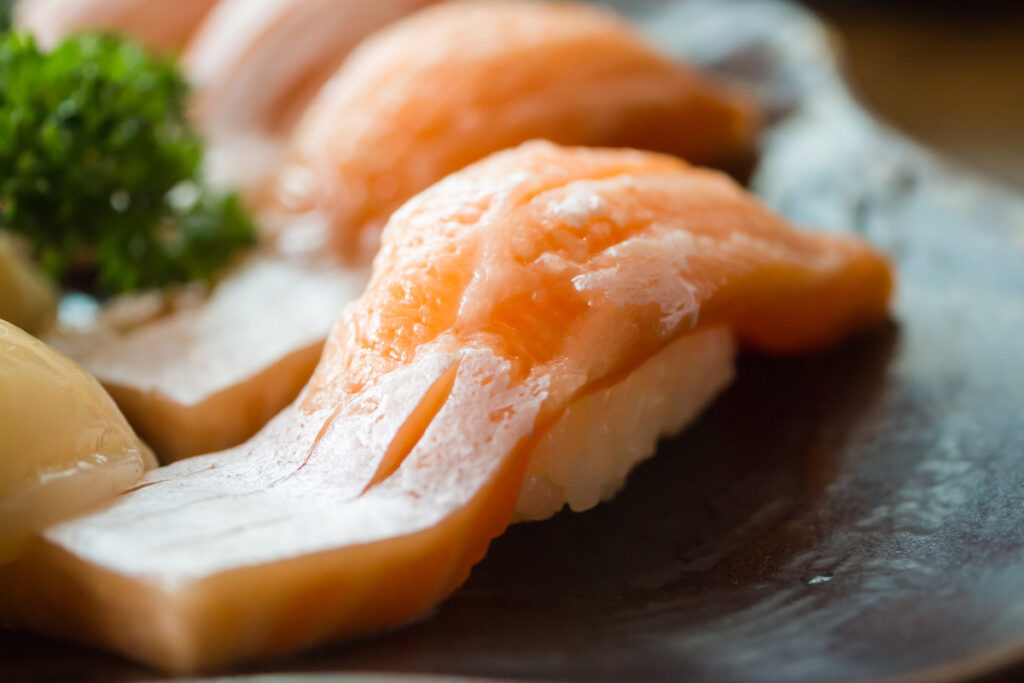
This sushi features the fatty part of the salmon, offering a rich and melt-in-the-mouth experience comparable to toro (fatty tuna).
Aburi Salmon
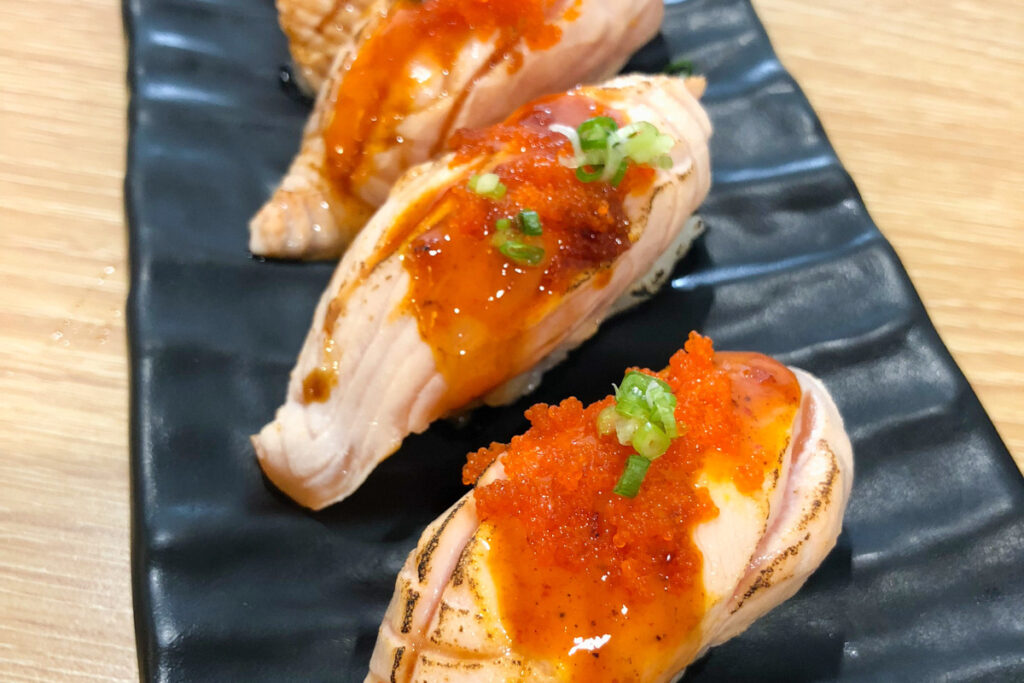
Aburi salmon is lightly seared, eliminating any raw fish aroma and enhancing the flavor. It is often paired with mayonnaise and other toppings for a delicious combination.
Salmon Carpaccio and Salmon Onion
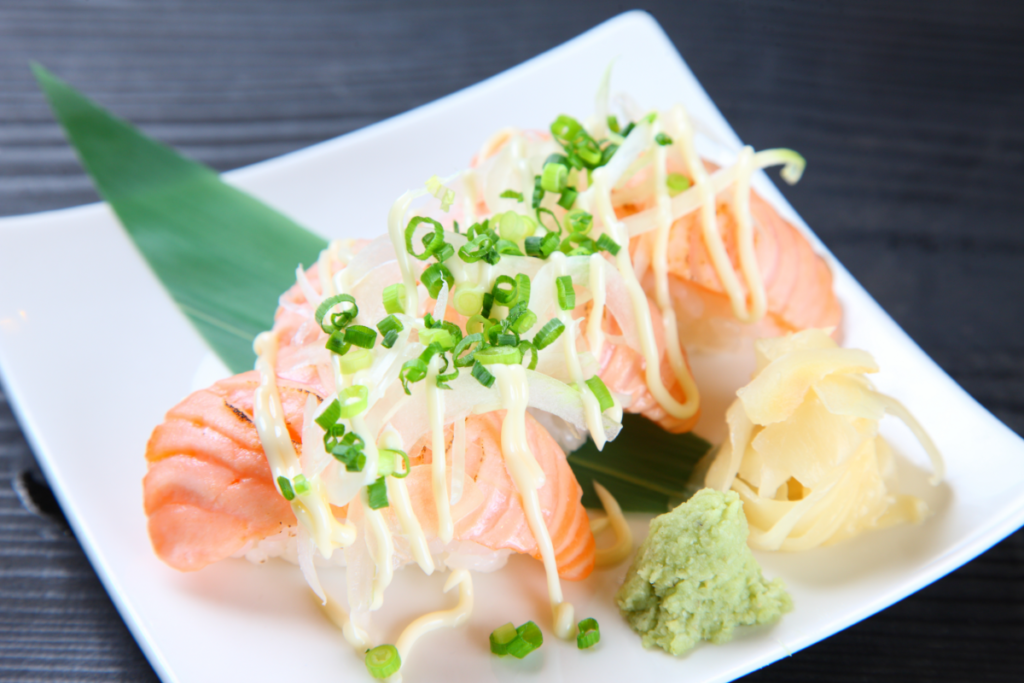
These are Western-style dishes where thinly sliced salmon is served with onion slices and dressing. Some variations also include avocado.
Salmon Shabu-Shabu
This sushi involves briefly dipping the salmon in hot water, similar to shabu-shabu, making it easy to eat. It’s typically enjoyed with a ponzu dipping sauce, providing a refreshing flavor.
Flavor and Nutrition of Salmon Sushi
Salmon sushi is well-loved by people who may not necessarily enjoy raw fish or sushi, both domestically and abroad. Farmed salmon, which is the primary source for sushi, has a mild flavor with minimal fishy aroma, making it easy for those unaccustomed to raw fish to enjoy. It’s also a beginner-friendly sushi option. Additionally, salmon is known for its nutritional benefits. Let’s take a look at the key nutrients and their effects found in 100g of salmon:
Nutrients in Salmon (per 100g)
Protein (19.6g): Essential for building muscle and organs.
Vitamin D (7.3μg): Supports various bodily functions.
Docosahexaenoic Acid (DHA, 540mg): Helps prevent atherosclerosis and blood clotting.
Eicosapentaenoic Acid (EPA, 360mg): Known as EPA, it helps prevent blood clotting.


